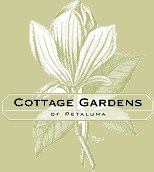
From Bare-Root "Sticks" to Bountiful Harvests -
It's Bare-Root Fruit Tree Season!
Saturday January 6 , 2024
Plucking mouthwatering fruit from your own, home-grown fruit tree is ridiculously rewarding. Growing your own fruit has so many benefits too - it lowers your carbon footprint (that luscious peach you're biting into was not driven in from an orchard in Georgia), reduces your grocery bills, and puts you in charge of how your pears, plums, cherries and apples are grown and cared for. No matter which growing practices you use, backyard produce tastes better than store-bought, but if you garden organically, you know your bounty is safe to eat, better for the planet, and extra nutritious!

January is the best time to source new fruit trees. Bare-root season is here and Cottage Gardens is fully stocked with the most variety of the year.
Choosing The Best Fruit Tree for your Garden
Does your family look forward to cherry season every year? Bring home a bare-root 'Stella' or ‘Bing'! Not only do they produce big harvests of delectable cherries, but they're delightfully ornamental, with beautiful bark and a canopy full of fluffy white blossoms (that pollinators LOVE) in early spring. If you long to share home-grown crisp, sweet, juicy apples with your co-workers, choose 'Gala'. It's a high yielding, old-style variety, plus it's fragrant, super tasty and stores well. 'Elephant Heart' plum is the perfect plum - large, heart-shaped, meaty, sweet and deliciously juicy. When it comes to pears, 'Seckel' - a chubby, round, short-necked pear - is a staff favorite here at Cottage. Naturally snack-sized, with a sweet crisp yet juicy texture, and a hint of vanilla to the flavor. ‘Seckel' poaches beautifully and makes THE best pear butter!

Imagine yourself snacking on, sharing or cooking with your favorite fruit at harvest time. That's the tree you need! Then, consider the amount of space you can allow for your fruit tree(s). Read on for rootstock info to help determine which one's best for your landscape. Then come on in, and let us help you pick out a stocky, sturdy well-branched bare-root tree.
Rootstocks
Most fruit trees are actually two varieties grafted together. The upper part of the tree (scion) is the part we're familiar with - the 'Gala' apple, 'Seckel' pear, or 'Elephant Heart' plum - and it's grafted onto the second (mostly underground) variety or rootstock. Rootstock determines the size, disease resistance and conditions (soil type or heat-cold tolerance for example) your tree can tolerate. Standard rootstocks produce the biggest trees which can reach 35' tall. Semi-dwarfing rootstocks produce 16-20' trees. Dwarfing rootstocks result in the smallest trees - from 5' to 10' tall. Pay attention to the rootstock when choosing your tree. Fruit trees with dwarfing rootstocks are perfect for containers or tiny gardens, while fruit trees on standard rootstocks need a minimum of 15' clearance all round! Fruit trees with semi-dwarfing rootstocks are usually the smartest option for most backyard orchards. We've already done the hard part and picked great rootstocks for all you budding Northern California orchardistas.
Exposure
Fruit trees are most productive and healthiest planted in a full sun location - one that receives at least 6 hours of sun per day during the growing season.
How To Plant a Bare-Root Fruit Tree
Dig the hole at least one foot wider than the spread of the roots, and half again as deep. Fill the bottom 2-4" of the hole with a mixture of 50% native soil and 50% organic compost, plus 1-2 cups of Earthworm Castings. Press this mixture down, then create a small mound in the center of the hole, setting your new tree upright with the stem centered and the roots spread over the mound as evenly as possible. The graft should be positioned about 2 inches above ground level, facing north. Fill the hole completely, using a 50-50 blend of native soil and organic compost or our wonderful Soil Booster, adding a handful of EB Stone's Organic Citrus and Fruit Tree fertilizer at the same time. Make a "basin" for holding water around the tree and slowly fill with water to settle the soil around the roots. Finally, top it all off with a 2" layer of mulch to conserve moisture and prevent weeds.
Watering
Until your fruit tree is established, water when the top 1" of soil is dry and the soil 6" below the surface is just barely moist. Apply enough to wet the soil 3 to 4 feet deep. Mature trees require less diligent watering, but should still be irrigated regularly during summer.

Feeding
Feed your new tree 3-4 times during the growing season with an organic, well-balanced fertilizer such as E.B. Stone Citrus and Fruit Tree Food. Avoid fertilizers too high in nitrogen as they stimulate leafy growth at the expense of fruit production. No need to fertilize during the dormant season, but applying a 2-3" layer of our Organic Compost or Soil Booster is very much appreciated.
Pruning
The success of your fruit tree depends upon the initial training and pruning during the first three years. I recommend keeping fruit trees shorter to make monitoring, troubleshooting, pruning, spraying, protection (birds and other critters love ripe fruit as much as we do) and harvesting much easier. It also lets you squeeze more fruit trees into your backyard orchard. For healthy, productive fruit trees, get tips from your local garden center, or do your research online. Dave Wilson Nurseries has very helpful "Backyard Orchard Culture" pruning tips and how-to videos that are indispensable for any gardener.
by Fionuala Campion
Click HERE to return to our front page.